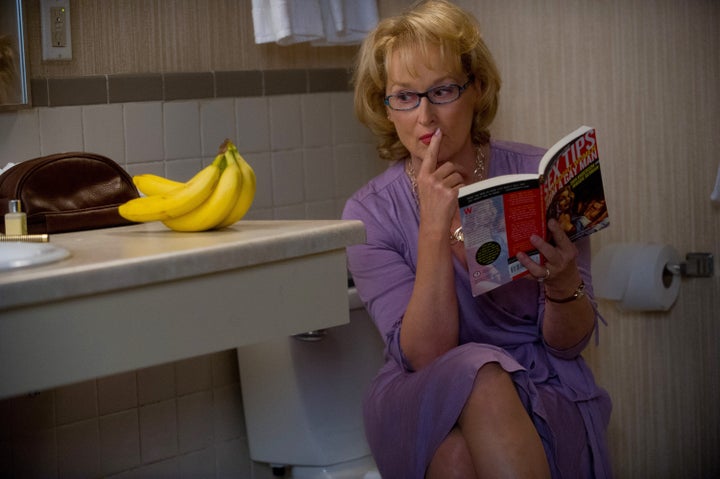
I saw the Meryl Streep and Tommy Lee Jones movie Hope Springs the day after it opened and I was surprised at the filled theatre on a summer Saturday afternoon. The average age of audience was on the older side of the spectrum, but not exclusively. Several conversations with my clients (ages 35-75) throughout the past few weeks about the film have shown me that the movie hits a collective nerve. Many people have said they see themselves in the characters -- either Kay (Streep) or Arnold (Jones), regardless of their own gender.
This is the first movie since It's Complicated that portrays sexual relationships in folks past 40. It bravely tackles the complex issues of sexual desire and intimacy in "seniors," however we may define that term. As a sex therapist and a senior myself, I am very interested in this new conversation. What is fascinating for me is that the film simultaneously breaks through and also sometimes perpetuates some of the prevailing myths about sex and aging in our culture. But as Arnold and Kay begin to unravel all the delicate barriers to intimacy they have built over the years, we start to root for them to succeed.
Myth # 1 Good sex is about virtuoso performance. The movie portrays both Arnold and Kay's perception that the best way to win (or win back) our mate is improved performance. Kay goes to the local bookstore to learn fellatio techniques but what truly matters is her willingness to reach beyond her comfort zone. The botched scene in the movie theatre where she attempts oral sex, much to Arnold's discomfort, is awkward, but Arnold begins to understand how important their sexual relationship is to Kay.
Some people may be confused about what happened during the scene on the hotel floor by the fireplace. Arnold nearly gives up the relationship when he looses his erection in their first attempt after many dry years. Kay believes that this experience proves that he is not attracted to her. The truth is that most people fall short of some aspect of the performance model. 40% of men over 40 have erectile issues.
More importantly, many people in long-term relationships lose sexual interest because genitally-focused sex in rote patterns purely for physical release becomes boring without additional paths of emotional and spiritual discovery. Telling the truth to each other is risky but it is also the turning point, as we see with Arnold and Kay.
Myth # 2 Sexual desire is about being attractive (in some culturally acceptable way) to our mate. Kay believes that her husband hasn't been attracted to her. In the opening scene she is obviously nervous, fluffing her hair, fixing her makeup and adjusting her new lingerie, which she desperately hopes is flattering enough to get Arnold's interest going. When she arrives at his (separate) bedroom, he looks at her, clearly noticing the gown, but finesses away from acknowledging her offer. She is too shy to express what she wants and walks away dejected.
So many women who come into therapy thinking their partner's lack of interest is their fault. But the desire discrepancy stalemate effects almost all couples in long-term relationships at some point. Even when sex occurs, it is constricted by performance anxiety and negative thoughts that surround the whole process. Many men and women have lost access to desire because of misunderstandings and misperceptions which have at their heart the lack of permission to enjoy pleasure without living up to an impossible ideal. The 'gold standard' for sex is patterned after youthful single life and memories of early courtship days.
Healthy sexuality at any age is:
• The ability to receive pleasure and feel good about your own erotic sensations
• The ability to give pleasure and enjoy your partner's responses, paying attention to your partner's wants without loosing sight of your own pleasure
• The openness to new experiences and sexual possibilities rather than rigid routines
Sexuality is energy and it is available lifelong for both men and women. When we look at an expanded view of sexuality, one I've called the Pleasure Model, there are so many possibilities. The goal is simply a pleasurable encounter where partners feel good about themselves and each other, with no particular act or endpoint required.
Myth # 3 Sex should be natural and spontaneous (the way it used to be).When Kay and Arnold are given a simple touch exercise to practice back in their hotel room, Kay begins to feel good as her hands move up Arnold's legs; breathing patterns change for both of them but Arnold aborts the exercise because his arousal makes him anxious. This scene may be confusing to the viewer, but it is not uncommon when couples begin to feel something after a long hiatus in their sex life. There may be many reasons, for example: fears about 'performing properly' and awkwardness about what might happen next. My guess is that Arnold was used to the distance in the relationship and the possibility of renewed intimacy made him uncomfortable.
The assigned exercise of touching seems "too clinical" or unnatural to some couples but I tell them that inertia needs a push to get moving again. Returning to simple touch is the essential ingredient. Starting with a safe touch -- no nudity, eliminating the obvious body parts that spell "sex is going to happen" and simply enjoying the sensations is the best way to clear the path strewn with obstacles.
Myth # 4 It is easy to tell who has more desire and who has less desire in a relationship. Just like Arnold and Kay, couples arrive in sex therapy with some entrenched notions about what desire is, and who has less desire and who is more sexual. One important obstacle is dissimilar intentions for a sexual encounter: The desire to simply have an orgasm is very different than the desire to make love. One partner may be longing to feel connected before the 'tingly genitals' part. Desire is most certainly a complex interweaving of mind, body and emotions. The partner who is interested in appetite sex is often viewed as the "high desire" person, yet the low desire partner may be more interested in connection, which is why Kay opted out of the rote sex occurring in their marriage for many years. In the movie, Kay turns Arnold's head and asks him to look at her in the fireside scene, which breaks up his concentration and he looses his erection, which results in Kay feeling rejected.
What I love about Hope Springs is that it is Kay who initiates the conversation and wants to renew sex in the relationship and Arnold who resists. This is far more common than many people believe. Desire is much more complicated than biological urges, so discussing their impasse with the therapist is crucial. The goal was to remove the blame and shame and then to initiate a creative dialogue.
Communication is crucial to help dispel prejudices. When Kay and Arnold actively listen to each other without judgment or reactivity in the therapist's office they are stepping into change but they still have a long road. Once Kay expresses her dismay with Arnold's "genital sex for release" approach, Arnold is offended and finally quits the therapy altogether because his pride gets in the way of difficult but necessary communication.
The good news is [spoiler alert] they ultimately find their way back to each other. We see the out-takes at the end of the movie showing their renewed liveliness, creativity and comfortable connection. This is the promise of lifelong intimacy.
